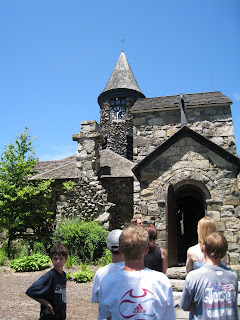 During this year's tours of St. Hubert's Chapel in Smoke Rise's Lake Kinnelon, Tom Kline shared an amazing new discovery: that the Chapel once housed a bronze statue of the Madonna and Child [pictured below] by Gustave Dore -- who also created the statue of Night, the location of which we discovered during The Old Birch Spring Trail...
During this year's tours of St. Hubert's Chapel in Smoke Rise's Lake Kinnelon, Tom Kline shared an amazing new discovery: that the Chapel once housed a bronze statue of the Madonna and Child [pictured below] by Gustave Dore -- who also created the statue of Night, the location of which we discovered during The Old Birch Spring Trail...How Tom came to this amazing discovery is fascinating.
It begins in Rhode Island. If you remember from an early Cornie Hubner Story [see Didja Know? The Cottage - Francis S. Kinney's Home], Francis S. Kinney spent time in Rhode Island, and more specifically, Narragansett, RI, where there still exists the Kinney Bungalow. [The Kinney Bungalow is owned by the town of Narragansett and managed by the Narragansett Land Conservancy Trust which has been in contact with the Kinnelon Historical Commission.]
 According to Tom, the Kinney Family owned not just the Kinney Bungalow, but also land [i.e., a farm] where the building was located, and a summer home. In early June, he visited Narragansett, to meet with the Narragansett Land Conservancy Trust and personally inspect the Kinney Bungalow and see the site where the Kinney summer home was.
According to Tom, the Kinney Family owned not just the Kinney Bungalow, but also land [i.e., a farm] where the building was located, and a summer home. In early June, he visited Narragansett, to meet with the Narragansett Land Conservancy Trust and personally inspect the Kinney Bungalow and see the site where the Kinney summer home was.Francis S. Kinney built the Bungalow in 1899 for his daughter, Beatrice's debutante party. However, the Trust believed that the daughter's name was Frances [You'll note in this web page about The Kinney Bungalow, the reference to a daughter named Frances.], a detail that Tom corrected the Trust on.
Shortly thereafter, Tom decided to research Beatrice online, both as "Beatrice Kinney" [note this fascinating article on Morris Kinney Gives Dance; Entertains for Mr. and Mrs. Harry La Montagne at Sherry's] and "Beatrice Kinney Lamontagne".
The second search led to link to a National Registry of Historic Places Inventory document for St. Mary Help of Christians Church in Aiken, South Carolina. Aiken, it seems, was a popular winter resort in the early 1900s.
Go to page 3 of that document and you will notice mention of a Gustave Dore bronze statue of the Madonna and Child. Look further on pages 5 and 7:
The Madonna was cast in bronze by the Thiebaut foundry in Paris shortly after the 1880 Paris Salon. It was purchased by a Mr. Kinney, who interred the statue in an island chapel on Kenlon, his Butler, New Jersey, estate. His daughter, Beatrice Kinney Lamontagne, acquired the statue after his death. A winter resident of Aiken, in 1947 she donated the Madonna to Monsignor George Lewis Smith and St. Mary Help of Christians church, where it remains today, as a memorial to her husband, Harry Lamontagne.

Tom then investigated Gustave Dore, a renowned French artist, engraver, illustrator and - later in life - sculptor. [This link shows you the many illustrations he did of Dante's Inferno, and other works by Dante, Tennyson, Balzac, Rabelais and others.] Now, check out this passage from the Life of Gustave Dore which describes that Dore exhibited great talent for - no, mastery of - drapery and that this was noticeable in his sculptures Glory, Night and Atropos and Love...
Night? Yes, that Night! The 'NIGHT' that appears carved into the rock along the Birch Spring trail... Eureka - on two counts!
As it relates to the Chapel, Tom explained that Dore's Madonna and Child occupied that space that for years he had said once held a baptismal font. Imagine as you walk into the Chapel on the right hand side, underneath the Celtic Cross window, seeing the statue pictured above on the large stone pedestal that is there now. As a reminder, it's two feet high, square along the back edge and sides and rounded on the front, and if you look at the floor, the mosaic pattern also follows the pedestal arc.
Truly an amazing St. Hubert's Chapel discovery.
For the record, over 100 people visited St. Hubert's Chapel this past July 5th, 2009.
In addition to the Madonna and Child discovery, Tom also pointed out the new windows inside the chapel and the new cross above the entrance door - which you can see in the photo on the left.
In a separate post, I'll share with you our adventure in the clock tower.
Technorati Tags: Kinnelon history Francis S. Kinney St. Hubert's Chapel Tom Kline Gustave Dore Madonna & Child Night Smoke Rise Del.icio.us Tags: Kinnelon history Francis S. Kinney St. Hubert's Chapel Tom Kline Gustave Dore Madonna & Child Night Smoke Rise







No comments:
Post a Comment